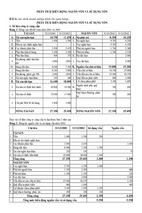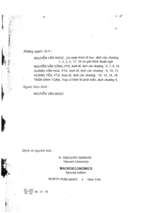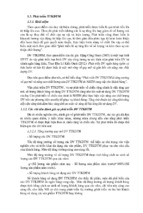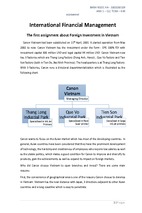4th Annual International Research Conference -2015
Determinants of Non-Performing Loan Facility in
Commercial Bank Industry, Batticaloa District- Sri
Lanka
Kirushanthy Kousthupamany
Trincomalee Campus, Eastern University, Sri Lanka
[email protected]
Abstract
The banking sector is an inevitable financial service sector to support the
development of the nation through channelizing funds for productive purpose,
intermediating flow of funds from surplus to deficit units and supporting
financial and economic policies of the government. The Sri Lankan commercial
banking sector accounts a major portion of financial intermediation and
acknowledged as main tool of monetary policy, credit channel and facilitator for
payment systems. Maintaining asset quality and profitability are critical for
banks survival and growth. A major threat to the banking sector is a prevalence
of Non-Performing Loans (NPLs).The NPLs are the cursor for poor regional and
economic development. Recent records motions that the trend of NPLs in Sri
Lanka swings upward, especially the double effect in 2012. This study questions
why the commercial banks are far behind in managing the NPLs. As a result, this
research aims to understand and explain employing qualitative methodology to
identify the determinants of the NPLs in commercial banks in Batticaloa District
of Sri Lanka. Findings reveal that there are several banking specific factors,
customer related specific factors and macro environment factors influenced the
NPLs.
Keywords: Licensed Commercial Banks, Non-Performing Loans, Batticaloa
District
Introduction
The financial system is one of the most significant components in the economic system of
the country and it is considered as the main player in the economic model. A strong
financial system helps for industrial development, creation of direct or indirect
employment, enhancing the gross domestic product. Finally, it leads to the country‘s
prosperity and economic development (Babihuga, 2007). In general, the financial system
consists of the regulatory authorities, financial institutions, markets, instruments, a
payment and settlement system, a legal framework and regulations (CBSL).
The banking industry is a core unit in the financial institutions and plays a dominant
role in the financial system. As bank is one of the players in the economic models, it
channels funds from surplus unit (those who have excess) as deposits to deficit unit (who
need it for their investment) as loans or advance. These functions perform through the
effective intermediation role. This intermediation role links the householders, private
211
4th Annual International Research Conference -2015
sectors and government sectors of the economic models for their respective needs
accomplishments (Bossone B, 2009).
Lending is the core function in the intermediation process, which plays a significant
contribution in generating income to the bank and it revitalizes investment in the industrial
development. It is one of the units in economic models and their channels funds from
surplus unit of household, private sector and government sectors to deficit unit of
household, private sector and government sector for development purpose. Though the
strong banking performance is not only given the stability to the bank, it contributes
country's stability as well. Mac Donald and Koch(2006) state loans are the dominant asset
and represent 50-75 percent of the total amount at most banks, generate the largest share of
operating income and represent the banks greater risk exposure. Moreover, its contribution
to the growth of any country is huge in that they are the main intermediaries between
depositors and those in need of fund for their viable projects (creditors) thereby ensure that
the money available in the economy is always put to good use. Therefore, managing loan
in a proper way not only has a positive effect on the bank‘s performance, but also on the
borrower firms and a country as a whole. Failure to manage loans, which make up the
largest share of bank assets, would likely lead to the episode of the high level of non performing loans. According to the International Monetary Fund (IMF, 2009), a nonperforming loan is any loan in which interest and principal payments are more than 90
days overdue; or more than 90 days‘ worth of interest has been refinanced .On the other
hand the Basel Committee1(2001) puts non-performing loans as loans left unpaid for a
period of 90 days.
The causes for loan default vary in different countries and have a multidimensional
aspect, both in developing and developed nations. Theoretically, there are so many reasons
as to why loans fail to perform. Some of these include depressed economic conditions,
high real interest rate, inflation, lenient terms of credit, credit orientation, high credit
growth and risk appetite, and poor monitoring among others. Bercoff et al. (2002)
categorizes causes of nonperforming loans to Bank specific and Macroeconomic
conditions.
Increasing levels of non-performing loans in the Sri Lankan banking industry has
been a hindrance to economic stability. According to Central Bank of Sri Lanka, status of
the Non-Performing Loan during last seven years is fluctuating. Though there seem to be
some improvements during recent quarters, the ratio still remains higher. It is evidenced
by CBSL that the Non-performing Loan ratio in 2012 has been doubled from 2011 and the
NPLs ratio in 2014 is recorded 6.2%. It is in above the standard and alarming the financial
institution and regulatory institutions vigilant on this aspect.
The aftermath of the post war period, banking services has been extended to the island
wide, especially in the North and eastern provinces for the regional growth. There are
ample of the credit facilities extended by the financial institutions to promote and develop
small medium business in the North and eastern region.
This research attempts to explore determinants of nonperforming loans in Batticaloa
District, Sri Lanka with the following objectives:
To identify levels of Non-Performing Loans ratio in Battticaloa District.
To identify the factors contributing to the Non-Performing Loan facility in the
Battticaloa District.
To identify the strategies to reduce the Non Performing of the banking Industry in
Batticaloa District.
212
4th Annual International Research Conference -2015
Literature Review
Definition of Non-Performing Loan
It is observed that there is no standard definition of NPLs and definition of NPLs vary
across the country. As per the Basel Committee on banking supervision, NPLs defined as
a default occurs when the bank considers that an obligor is unlikely to repay its credit
obligations to the banking group in full, without recourse by the bank to actions such as
realizing security (if held); or the obligor is past due for more than 90 days on any material
credit obligation to the banking group.
A Non-performing Loan/ Asset is a credit facility in respect of which, the interest and
or principal amount has remained past due for a specific period of time. According to
Alton and Hazen (2001) non-performing loans are those loans which are ninety days or
more past due or no longer accruing interest. Hennie (2003) agrees arguing that nonperforming loans are those loans which are not generating income. This is further
supported by Caprio and Klingebiel (1996), cited in Fofack (2005), who define nonperforming loans as those loans which for a relatively long period of time do not generate
income that is, the principal and or interest on these loans have been left unpaid for at least
ninety days. Non- performing loans are also commonly described as loans in arrears for at
least ninety days (Guy, 2011). According to this paper, nonperforming/Assets/ loans are
loans that are ninety or more days delinquent in payments of interest and/or principal
(Bexley and Nenninger, 2012).
Impact of Non-Performing Loan
Michael et al (2006) emphasized that NPL in the loan portfolio affect operational
efficiency, which in turn affects profitability, liquidity and solvency position of banks.
Batra, S (2003) noted that in addition to the influence on profitability, liquidity and
competitive functioning, NPL also affect the psychology of bankers in respect of their
disposition of funds towards credit delivery and credit expansion. NPL generate a vicious
effect on banking survival and growth, and if not managed properly lead to banking
failures.
Factors Contributing to the Non-Performing Loan
The theory of asymmetric information tells us that it may be difficult to distinguish good
from bad borrowers (Auronen, 2003), In Richard (2011), which may result into adverse
selection and moral hazards problems. The theory explains that in the market, the party
that possesses more information on a specific item to be transacted (in this case the
borrower) is in a position to negotiate optimal terms for the transaction than the other party
(in this case, the lender) (Auronen, 2003) in Richard (2011). The party that knows less
about the same specific item to be transacted is therefore in a position of making either
right or wrong decision concerning the transaction. Adverse selection and moral hazards
have led to significant accumulation of non-performing loans in banks (Bester, 1994;
Bofondi and Gobbi, 2003).
In scholar studies, problem loans are often used as an exogenous variable to explain
other banking outcomes such as bank performance, failures, and bank crises (Boudriga et
al., 2009). However, some studies investigate problem loans as an endogenous variable
(Sinkey and Greenwalt, 1991; Kwan and Eisenbeis, 1997; Salas and Saurina, 2002) in
(Boudriga et al., 2009). GDP growth, inflation and interest rates are common macroeconomic factors, while size and lending policy are micro-economic variables (Greenidge
and Grosvenor, 2010). These variables are by no means exhaustive, but they provide a
useful framework for monitoring the development of non- performing loans. Countries
213
4th Annual International Research Conference -2015
and emergent economies (Hauner and and Peiris, 2005; Matthewes et al., 2007), as cited
by (Maggi and Guida, 2009). Bercoff et al (2002) examine the fragility of the Argentinean
Banking system over the 1993-1996 period; they argue that non-performing loans are
affected by both bank specific factors and macroeconomic factors. To separate the impact
of bank specific and macroeconomic factors, the authors employ survival analysis. Using a
dynamic model and a panel dataset covering the period 1985-1997 to investigate the
determinants of problem loans of Spanish commercial and saving banks, Salas and Saurina
(2002) reveal that real growth in GDP, rapid credit expansion, bank size, capital ratio and
market power to explain variation in non- performing loans. Furthermore, Jimenez and
Saurina (2005) examine the Spanish banking sector from 1984 to 2003; they provide
evidence that non-performing loans are determined by GDP growth, high real interest rates
and lenient credit terms. This study attributes the latter to disaster myopia, herd behavior
and agency problems that may entice bank managers to lend excessively during boom
periods. Meanwhile, Rajiv and Dhal (2003) utilise panel regression analysis to report that
favourable macroeconomic conditions and financial factors such as maturity, cost and
terms of credit, banks size, and credit orientation impact significantly on the nonperforming loans of commercial banks in India. Babihuga (2007), in an IMF working
paper, explores the relationship between several macroeconomic variables and financial
soundness indicators (capital adequacy, profitability, and asset quality) based on country
aggregate data. She explained the cross-country heterogeneity by differences in interest
rates, inflation, and other macroeconomic factors. However, the study does not consider
the impact of industry specific drivers of problem loans. Most empirical studies examine
the influence of the macroeconomic environment on non-performing loans (Louzis et al,
2011). Rinaldi and Sanchis-Arellano (2006) analyze household non-performing loans for a
panel of European countries and provide empirical evidence that disposable income,
unemployment and monetary conditions have a strong impact on non-performing loans.
Berge and Boye (2007) find that problem loans are highly sensitive to the real interest
rates and unemployment for the Nordic banking system over the period 1993–2005.
Lawrence (1995) examines the theoretical literature of life-cycle consumption model and
introduces explicitly the probability of default. This model implies that borrowers with
low incomes have higher rates of default due to increased risk of facing unemployment
and being unable to settle their obligation. Additionally, in equilibrium, banks charge
higher interest rates to riskier clients. Rinaldi and Sanchis-Arellano (2006) extend
Lawrence‟s model by assuming that agents borrow in order to invest in real or financial
assets. They argue that the probability of default depends on current income and the
unemployment rate, which is linked to the uncertainty regarding future income and the
lending rates.
The benefits of diversification in the form of reduced risk, for the US banking system,
since non-interest income growth was highly correlated with net interest income during the
1990s. The moral hazard of too-big-to-fail banks represents another channel relating bankspecific features with non-performing loans (Louzis et al, 2011). A policy concern is that
too-big-to-fail banks may resort to excessive risk taking since market discipline is not
imposed by its creditors, who expect government protection in case of a bank‘s failure
(Stern and Feldman, 2004). Consequently, large banks may increase their leverage too
much and extend loans to lower quality borrowers (Louzis et al, 2011).
Boyd and Gertler (1994) argue that in the 1980s the tendency of US large banks
towards riskier portfolios was encouraged by the US government‘s too-big-to-fail policy.
On the other hand, Ennis and Malek (2005) examine US banks‘ performance across size
classes over the period 1983–2003 and conclude that the evidence for the too-big-to-fail
214
4th Annual International Research Conference -2015
distortions is in no way definite. Hu et al (2006) also show that bank size is negatively
related to non-performing loans. In a seminal study, Berle and Means (1933) in Louzis et
al. (2011) argue that dispersed ownership of corporate equity may lead to a poorer
performance of the firm as the incentive of shareholders to monitor the management
weakens. An opposing view is that an efficient capital market imposes discipline on firm‘s
management and therefore dispersed ownership should not have an effect on firm‘s
performance (Fama, 1980) as cited in (Louzis et al., 2011). A strand in the empirical
literature tests these contrasting views using loan quality as an indicator of riskiness but
evidence is inconclusive (Louzis et al, 2011). Iannotta et al. (2007) find a link between
higher ownership concentrations and loan quality using a sample of 181 large banks over
the period 1999–2004, thus lending support to the Berle and Means view.
On the other hand, Laeven and Levine (2009) employ data on 279 banks and find a
positive association between greater cash flow rights of a large owner and risk taking.
Furthermore, Shehzad et al. (2010) present empirical evidence, from a data set comprising
500 banks from 2005 to 2007, that ownership proxied by three levels of shareholding
(10%, 20% and 50%) has a positive impact on the non-performing loans ratio when the
level of ownership concentration is defined at 10% but a negative impact when the level of
level of ownership concentration is defined at 50%. Therefore, they suggest that sharing of
control may have adverse effects on the quality of loans extended up to a level, but in
cases of a strong controlling owner, bank‘s management becomes more efficient leading to
lower non-performing loans. Azofra and Santamaria (2011) find that high levels of
ownership concentration benefit both the bank‘s profitability and efficiency for a sample
of Spanish commercial banks.
Empirically, Novaes and Werlang (1995) report lower performance for state
controlled banks in Brazil and Argentina due the high proportion of problem loans given
to government. Micco et al. (2004), analyze 50,000 financial institutions with different
ownership types covering 119 countries. They conclude that non-performing loans tend to
be higher for banks with state ownership than for other groups. Hu et al. (2004) use a
panel of Taiwanese banks and find a positive correlation between capital share owned by
the state and the level of non- performing loans. Garcia-Marco and Robles-Fernandez
(2007) investigate the relationship between risk taking and ownership structure. They
document that commercial banks (mainly private owned) are more exposed to risk than
deposit banks (mainly state owned).
More recently Hu et al (2006) analyzed the relationship between non-performing
loans and ownership structure of commercial banks in Taiwan with a panel dataset
covering the period 1996-1999. The study shows that banks with higher government
ownership recorded lower non-performing loans. Using a pseudo panel-based model for
several Sub-Saharan African countries, Fofack (2005) finds evidence that economic
growth, real exchange rate appreciation, the real interest rate, net interest margins, and
inter-bank loans are significant determinants of non-performing loans in these countries.
The author attributes the strong association between the macroeconomic factors and nonperforming loans to the undiversified nature of some African economies.
Methodology
This study is explorative in nature and this method is generally used when the researcher
wants to identify key issues and key variables (Chris, 2013). Multistage sampling
methodology has been adopted, at the first stage; the convenience sampling adhered to
select banks‘ branches of Bank of Ceylon, Peoples Bank, Hatton National Bank, Seylan
215
4th Annual International Research Conference -2015
Bank, DFCC Vadhana Bank, NDB,NTB,Union Bank, MCB bank, Sampath Bank, and Pan
Asia Bank to be researched. At second level, since the study is significant at management
level and the expert perception has to be incorporated in the study in order to generate a
valid output, the judgmental sampling technique is employed to select Regional Managers,
Branch managers, Credit analysts and recovery officer.
The primary data for this research was collected using a questionnaire and interviews
of senior managers involved in lending activities. Structured questionnaires were
administered. An additional method of data collection was personal interviews with
executives and senior management in selected commercial bank. 70 open ended
questionnaire questionnaires have been issued to the targeted respondent. Further, six
interviews have been made, and excels and SPSS were used for data analysis.
Data Analysis
Respondent Analysis
Out of the seventy questionnaires issued to the Branch managers, Credit officers and
Recovery officers of the 23 selected commercial banks‘ branches in the Batticaloa District
in Sri Lanka, fifty two usable responses were collected. The response rate is 74% and six
interviews were conducted out of target 10 interviews. Despite this, the target population
was fairly represented considering that key senior managers who are relevant to the study
were interviewed. The results are shown in table 1 below.
Table 1. Details of the respondents
Intended
Respondents
10
70
80
Interviews
Questionnaire
Total
Successful
6
51
Response rate
60%
74%
Source: Complied data
Profile of respondents
Most of the questionnaire respondents were credit Officers representing 44% of the total
respondents. Branch Managers and Recovery Officers represent 35% and 15%
respectively of the total respondents, while regional managers represented 6%.
Table 2. Position of the Respondent
Position of the Respondent
Frequency
Percent
Regional Managers
Branch Managers
3
18
6%
35%
Credit Officers
23
44%
Recovery Officers
8
15%
Total
Source: Complied data
52
100%
216
4th Annual International Research Conference -2015
Their working experience indicates in table 3 below, 30% of the respondents‘ working
experience in banking industry belongs to the range between 5 years to 10 years. 28% of
the respondents‘ experience just less than five years. 26% of the bankers‘ experience lies
in the range from 15 years to 20 years.
Table 3. Experience of the respondents
Experience of the Respondents
Frequency
Percent
Under 5 years
15
28%
Between 5 and 10 years
16
30%
Between 15 and 20 years
14
26%
More than 20 years
8
15%
53
100%
Source: Complied Data
Level of Non-Performing Loan
The below table 4 shows the position of NPL of the licensed commercial Banks in
Batticaloa District, NPLs of the majority of bank is in the range of 3%-5%. 26% of the
bank‘s NPLs are above 10%. Only 13 % of the banks are below the 3%.
Table 4. Level of Non-Performing Loan in Batticaloa District
NPLs Ratio in Percentage
1%- 3%
No.of Bank
Percent
3.0
13%
3%-5%
8.0
35%
5%-8%
2.0
9%
8%-10%
4.0
17%
Above 10%
6.0
26%
Total
23.0
100%
Specific Factors contributing to the Non-Performing –Overall view based on
variables
As per the below table, above 80% of the respondent agreed that the borrowers‘ poor
business knowledge and management skills for the main reason for the NPLs of the area.
Nearly 77% of the respondent agreed that the difficult to obtain proper data from customer
poor record maintenance by customer (Accounting) is a one of the causes for the NPLs.
Over/under financing for the project by banks, Lack of tight credit monitoring, Willful
defaulter are the factors which have been agreed by more than 50% of the respondents.
217
4th Annual International Research Conference -2015
Table 5. Specific Factors for NPLs
CRSF
: Customer Related Specific Factor
Categories
Frequency of
Agreement
42
(Respondent)
40
Percentage Rank
of
81%
1
Agreement
77%
2
CRSF
CRSF
Specific Factors
Poor business knowledge and management
skills record
of borrowers
Poor
maintenance by the customer
BRSF
Over/under financing for the project by bank
34
65%
3
BRSF
Lack of tight credit monitoring
34
65%
3
CRSF
Willful defaulter
Fund diversion by the customer for
unprofitable
sourcefor construction company
Delays in payment
29
56%
5
29
56%
5
24
46%
7
from
government
Unforeseen
Business risks
Improper selection of customers due to the
competition
among
banksagriculture
Natural disaster
affecting
24
46%
7
23
44%
9
17
33%
10
17
33%
10
12
23%
12
BRSF
Poor credit evaluations by credit analysts due
to the lack of of
knowledge
of
Inexperience
managersand
andinexperience
other delegates
credit
staff.
about
market
Poor portfolio diversification
12
23%
12
EERSF
Macroeconomic policies
11
21%
14
BRSF
Improper collateral selection
9
EE
International pressure
8
15%
15
BRF
Inadequacy of credit policies
6
12%
16
EERSF
Government interference in sanctioning loan
4
8%
17
CRSF
Compromised integrity of bank staff
4
8%
17
CRSF
EERSF
EERSF
BRSF
EERSF
BRSF
BRSF
BRSF : Bank Related specific Factors
EERSF : External Environment related specific Factors
In addition to that, delays in payment for construction company from government,
Unforeseen Business risks, Improper selection of customers due to the competition
among banks, Natural disaster affecting agriculture, Poor credit evaluations by credit
analysts due to the lack of knowledge and inexperience of credit staff, Inexperience of
managers and other delegates about the market ,Poor portfolio diversification ,
Macroeconomic policies, Improper collateral selection, International pressure, Inadequacy
of credit policies, Government interference in sanctioning loan, and Compromised
integrity of bank staff. Below 50% of the respondents have agreed the above factor to
cause the Non-Performing loan.
Discussions
The study shows the NPLs ratio of the each branch of the selected banks in Batticaloa
District. CBSL standard says that a healthier bank should maintain NPLs ratio below the
industry average in Sri Lanka. The study shows above 50% of the branch banks‘ NPLs is
above the 5%. It is apparently revealed, the newly opened banks in the area find difficulty
in managing NPLs. The senior managers pinpointed that new branches face several
difficulties in capturing market share in the area and in order to meet their annual target,
218
4th Annual International Research Conference -2015
they have to concentrate aggressive lending to meet their given targets. Comparatively the
existing established bank branches records low NPLs mainly due to their effective
management of credit.
The study analyzed each factor that has an impact on occurrences of nonperforming
loans. There are several factors contributes to the NPLs in the Licensed Commercial bank
in the Batticaloa district. Generally, we can categorize these factors into bank specific
factors, Customer specific factors and external environment related factors. (Bercoff et al
2002).
In respect of the factors affecting NPL, the subjective question in the survey and in-depth
interviews identified factors such as borrowers‘ poor business knowledge and management
skills, difficulties in obtaining proper data from customer as poor record maintenance by
customer (Accounting), Over/under financing for the project by the bank, lack of tight
credit monitoring, willful defaulter, fund diversion by the customer for unprofitable source
ascribe to the causes of NPLs.
81% of the bankers responded that the poor business knowledge and management
skills of borrowers are the main reason for NPLs. In depth interview reveals that lack of
entrepreneurial culture for unsustainable business efforts are the main reasons that the
entrepreneurs fail to ensure the success of the business. Further, though the young
entrepreneurs have entrepreneurial culture, they struggle to position their business. It is
observed in the district that the most of the entrepreneurs frequently switching from
existing business to new business for rapid income earnings without doing proper market
analysis. The unstable business decision may hit the entire investment of the young
entrepreneurship and it may impact the loan given by the banks. This is a big challenge
for the bank to provide loan facilities for young entrepreneurs.
The above analysis shows that the 77% of the respondents agreed that the poor record
maintenance of the customer is a main reason for the poor credit evaluation of the credit
analyst. In this area, most of the customers do not have a proper record to reveal a real
status of financial and accounting, operational, marketing performance. This leads to the
asymmetric information to the bankers about the customer.
It is observed 65% of the respondents agreed that over financing or under financing
towards client‘s projects by the bank is a major concern. The most of the projects have
been financed without considering the feasibility study, marketing analysis, and technical
feasibility. Even banks, they fail to identify the real debt and equity ratio of the particular
project of customer. It is mainly due to the inexperienced credit officers and managers in
the field.
Another most important reason for NPLs is lack of tight credit monitoring. The
delegated monitoring theory says, the bank plays an intermediation role to invest the
depositors‘ funds to financial claims of the corporation or individual. As part of the
intermediation role bank has to be monitored the investment on behalf of depositors
(Saunders and Cornett, 2003). Agresti et al. (2008) stated that it would help ensure a sound
financial system and thereby prevent systemic crises that otherwise would lead to loan
default. This study also indicates 65% of the respondent agreed. There is also a tendency
by borrowers to give more attention to repaying loans if they are properly given attention
by banks. Otherwise borrowers would be tempted to divert the fund to other purposes, as
was also learnt through the in-depth interview. Thus, failing to monitor loans would lead
to default. Bercoff, Giovanni and Grimard (2002) showed that operating efficiency helped
explain NPLs. i.e. banks that incur big cost for loan follow-up would have a comparatively
lower nonperforming loan. Respondents had a neutral view to the statement that banks
which allocate higher budget for loan monitoring would have a lower NPL. The essence
219
4th Annual International Research Conference -2015
seems to be having a proper system in place to proactively follow up loans than magnitude
of budget allocated.
According to the Reserve Bank of India, willful default occurs when a loan isn‘t
repaid even though the cash is available, or when money lent for a particular purpose is
used for something else. In the Batticaloa district, especially in the government sector,
some customers have intentionally escaped from their obligations. Further, it is noted
some NPLs cause of diverting the loan funds to unprofitable investment, it has been
observed in the area that the customers are very keen to invest their borrowed money from
banks to various unprofitable activities such as: building up luxury house, land, this causes
the bankruptcy of the main business of the customer.
Improper selection of the customer by banks is another reason for the NPLs, aftermath
of post war, the government extended their support to open up new bank branches in
order to enhance the regional development of the district. The bank‘s branch has opened in
the area, as the supply of bank branches radically increased the area, people have the
opportunity to cater their financial this leads to the intensified competition among the
financial institutions in the District. Unfair industry competition among banksendangering banks not select good customers. Sometimes non-performing loans of other
banks are bought from other banks. Salas and Saurina (2002) who studied Spanish banks
found out that credit growth is associated with non-performing loans.
Especially for the agriculture industry in the area heavily affected by vulnerability of
the climate conditions in the area. The farmers who obtained financial assistance from the
banks were not in the position to repay their obligations on timely manner as their
production/ crops have been hit by the flood or drought, this caused for the loss of
production and most of the customers have not claimed from the insurance company
because of the asymmetric deals with customers and insurance companies.
Further, the respondent says that the most of the rice millers were affected by the
control price of rice and imported rice from India. This sudden implementation severely
affects the business performance of the rice millers in the region. It is indirectly affected
the banks through nonpayment of the loan facility.
Lack of experience of the credit officers is the main reason for the NPLs. Since most
of the bank‘s branches newly opened branches in the district, most of the banks have
worked with fresh employees who are newly recruited to the banking industry.
Experience in the industry very low compared to well-established branch banks.
As the knowledge and experience is limited to the customer, the banks fail to
scrutinize the customer business position and the real requirements of the customer in a
proper manner. In some case, the managers and credit officers fail to identify it.
As most of the lending in the district is based on collateral rather than cash flow based
lending. As such obtaining good collateral is most important to minimize credit risk as a
secondary source of payment (Koch & MacDonald, 2003).In some instances the selection/
identification of good collateral is a questionable in the area. Most of the NPLs loan
backed by the residential property for commercial purpose. Some properties are
overvalued by valuers. As such at the time of liquidation of the collateral, the bank has
faced legal problem and social problem.
Conclusion
According to the study, there are several factors identify for NPLs of the licensed
commercial banks – Batticaloa District. Most of the instances the banks related factors
influence the NPLs in the region those are: Over or under financing projects, Lack of
220
4th Annual International Research Conference -2015
tight credit monitoring, poor credit evaluation, poor portfolio diversification, improper
collateral selection, inadequacy of credit policy are the main factors in bankers side .
However the bankers, they pointed out that there are customer related factors such as poor
business knowledge, poor record maintenance, diversion of funds and willful defaulter
were the main reason for the NPLs. Further, NPLs occurs in the specific sectors like
Agriculture and fishing, and construction, this is mainly due to the macro environmental
factors. In order minimize the NPLs, the bank may respond in following manner, Banks
should put in place a vibrant credit process that would encompass issues of proper
customer selection, robust credit analysis, authentic sanctioning process, proactive
monitoring and follow up and clear recovery strategies for sick loans. Banks should put in
place a clear policy framework that addresses issues of conflict of interest, ethical
standards, check and balance in the decision making process for all those involved in the
credit process ensure its implementation thereof. Banks should pursue a balanced approach
of profit maximization and risk management, lest they engage in aggressive lending and
unhealthy competition that would lead to selecting borrowers that would default. Banks
should give due emphasis it takes to develop the competency of credit operators,
information system management pertaining to credit and efficiency of the credit process.
It is apparent that banks need to seriously consider all the customer, bank and external
environmental related factors carefully. The impact of environmental factors such as
natural disasters and government policy should be considered seriously during the credit
assessment process. The bank should slow down on issuing loans to companies in the
agricultural and manufacturing sectors as they are currently not performing well. Loans in
these sectors should only be granted if the borrower proves that they have the capacity to
pay back loans given. Management needs to ensure that borrowed funds are being used for
the intended purpose through enhanced credit monitoring. This can be achieved by
adopting a relationship management approach which helps management to have a closer
look at the business as well as the characters of the senior managers running the
organization.
Reference
Alton R. G and Hazen J. H (2001), ―As Economy Flounders, Do We See A Rise in Problem Loans?
Federal Reserve Bank of St. Louis.
Azofra V, Santamaria M (2011), Ownership, control and pyramids in Spanish commercial banks,
Journal of Banking and Finance 35, 1464–1476.
Babihuga R (2007), Macroeconomic and Financial soundness indicators: An empirical
investigation‟, IMF working paper, no.115, 2007.
Bercoff J. J, Julian di G and Grimard F (2002), ―Argentinean Banks, Credit Growth and the Tequila
Crisis: A Duration Analysis‖
Berge T.O and Boye K.G (2007). An analysis of banks problem loans, Norges Bank Economic
Bulletin 78, 65–76.
Bexley J. B and Nenninger S (2012), Financial Institutions and the Economy. Journal of Accounting
and Finance, 12(1) 2012.
Bofondi M and Gobbi G (2003), Bad Loans and Entry in Local Credit Markets, Bank of Italy
Research Department, Rome. Borio C and Lowe P (2002), Assessing the Risk of Banking
Crisis, BIS Quarterly Review, 43 – 54.
Bossone B (2001), Do banks have a future? A study on banking and finance as we move into the
third millennium. Journal of Banking & Finance 25, 2239-2276.
Boudriga A, Taktak N. B and Jellouli S (2009).Banking supervision and nonperforming loans: a
cross-country analysis. Journal of Financial Economic Policy, 1(4), 286-318.
Caprio G Jr and Klingebiel D (1996), Bank Insolvency: Bad Luck, Bad Policy or Bad Banking,
Annual World Bank Conference on Development Economics.
221
4th Annual International Research Conference -2015
Ennis H and Malek H (2005), Bank risk of failure and the too-big-to-fail policy. Federal Reserve
Bank of Richmond Economic Quarterly (91/2), 21–44.
Espinoza R and Prasad A (2010), Non-performing loans in the GCC banking system and their
macroeconomic effects, IMF Working Paper, WP/10/224.
Fofack H (2005), Non-Performing Loans in Sub-Saharan Africa: Causal Analysis and
Macroeconomic Implications, World Bank Policy Research Working Paper No. WP 3769.
Garcia-Marco T and Robles-Fernàndez M. D, .Risk-taking behavior and ownership in the banking
industry: The Spanish evidence. Journal of Economics and Business, Vol. 60, no. 4, 2007, pp.
332-354.
Greenidge K and Grosvenor T (2010), Forecasting non-performing loans in Barbados. Journal of
Business, Finance and Economics in Emerging Economies, 5, 80-107.
Guy K (2011), Non-performing Loans. The Central Bank of Barbados Economic Review Volume
XXXVII, Number 1.
Hu J, Yang L, Yung-Ho C (2004) .Ownership and non-performing loans: evidence from Taiwan‟s
banks. Developing Economies Journal, 42(3), 405–420.
Iannotta G, Nocera G and Sironi A (2007), Ownership structure, risk and performance in the
European banking industry. Journal of Banking and Finance, 31, 2127–2149
Jimenez G and Saurina J (2005), ―Credit cycles, credit risk, and prudential regulation‖, Banco de
Espana, May 2007.
Laeven L and Levine R (2009), Bank governance, regulation and risk taking. Journal of Financial
Economics 93, 259–275 Lawrence E (1995). Default and the life cycle model. Journal of
Money, Credit and Banking 27, 939–954.
Louzis D. P, Vouldis A. T, and Metaxas V. L (2011). Macroeconomic and bank-specific
determinants of non-performing loans in Greece: A comparative study of mortgage, business
and consumer loan portfolios. Journal of Banking & Finance,36(4), 1012-1027.
Maggi B and Guida M (2009), Modeling non-performing loans probability in the commercial
banking system: efficiency and effectiveness related to credit risk in Italy, IMF Working Paper.
Rajiv R and Dhal S C (2003), ―Non-performing Loans and Terms of Credit of Public
Sector Banks in India: An Empirical Assessment‖ Occasional Papers, 24:3, pp 81121, Reserve Bank of India.
Rinaldi L, Sanchis-Arellano A. (2006), Household Debt Sustainability: What Explains
Household Non-performing Loans? An Empirical Analysis, ECB Working Paper.
Salas V and Saurina J (2002), „Credit risk in two institutional regimes: Spanish
Commercial and Savings banks‟. Journal of Financial Services Research, 22(3), 203224.
Salas V and Saurina J (2002). Credit Risk in Two Institutional Regimes: Spanish
Commercial and Savings Banks. Journal of Financial Services Research, 22(3), 203224.
Saunders, A and Cornett, M.M (2003), Financial Institution Management, McGraw Hill
Publishing.
Shehzad C, de Haan J and Scholtens B (2010). The impact of bank ownership
concentration on impaired loans and capital adequacy. Journal of Banking and
Finance 34, 399–408.
Stern G, Feldman R (2004), Too Big to Fail: The Hazards of Bank Bailouts, The
Brookings Institution, Washington, DC.
222




















